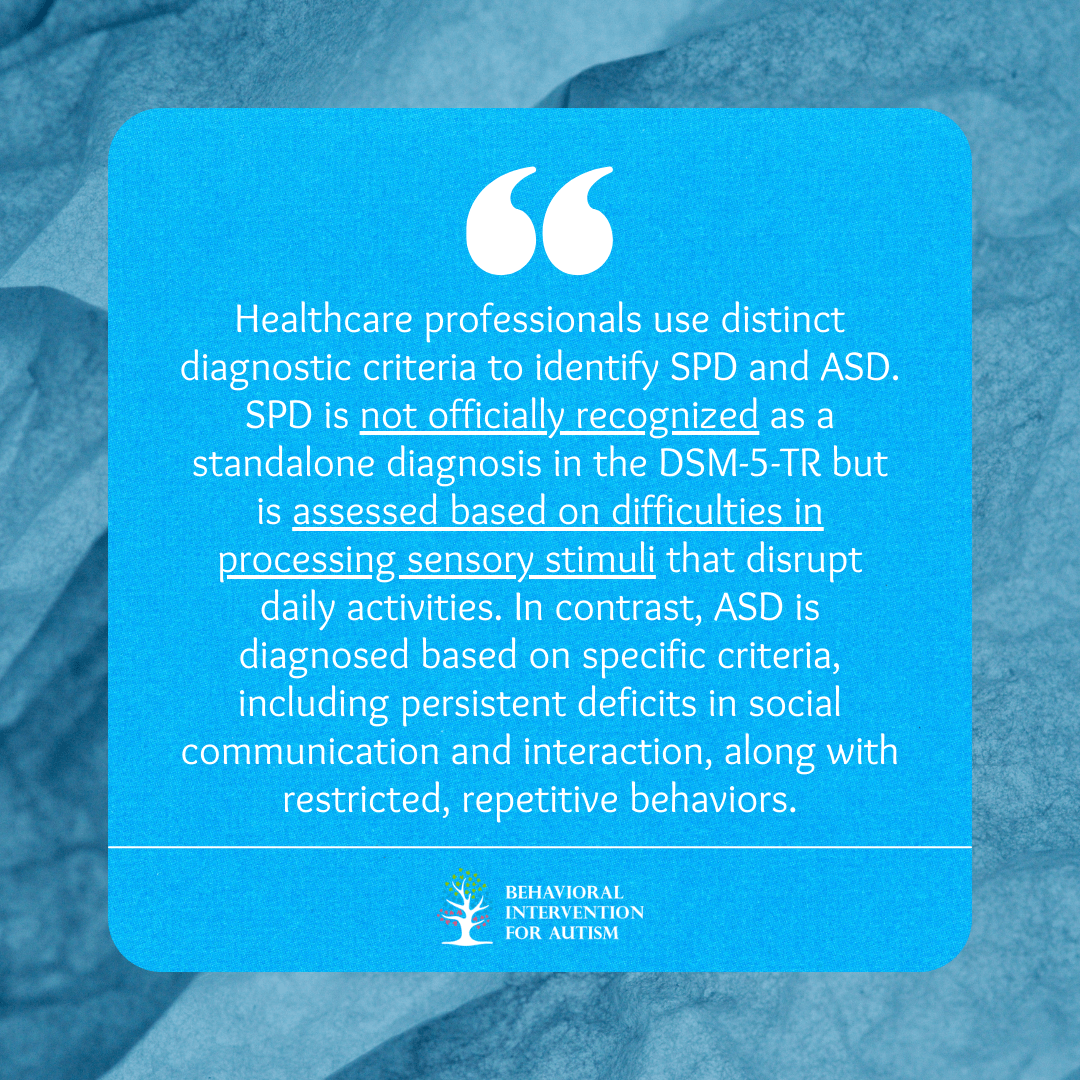
Table of Contents
Understanding sensory processing disorder (SPD) is essential for parents and caregivers supporting individuals with autism spectrum disorder (ASD). SPD involves difficulty processing sensory information, leading to hypersensitivity or hyposensitivity, which affects daily activities and social interactions.
SPD is closely linked to ASD, with up to 90% of individuals with autism experiencing sensory processing issues. The DSM-5 identifies “hyper or hypo reactivity to sensory input” as a behavior associated with ASD, though not all individuals with SPD have autism.
Recognizing the connection between SPD and ASD helps caregivers tailor interventions to meet the unique needs of individuals with these conditions. By understanding and addressing sensory challenges, caregivers can create supportive environments that improve the quality of life for those with ASD.
Signs and Symptoms of Sensory Processing Disorder
Understanding the signs and symptoms of SPD is crucial for early identification and appropriate intervention. Individuals with SPD may exhibit various behavioral indicators and sensory processing challenges that can impact their daily lives significantly.

Behavioral Indicators
Children with SPD often display a range of behavioral indicators that can vary in intensity and presentation. These indicators may include:
- Overreaction or underreaction to sensory stimuli (e.g., sounds, lights, textures)
- Heightened sensitivity to certain smells, tastes, or textures
- Difficulty with transitions or changes in routine
- Avoidance of certain textures of clothing or foods
- Motor coordination difficulties
- Emotional dysregulation in response to sensory input
Recognizing these behavioral signs can help caregivers and healthcare professionals identify and address the specific sensory needs of individuals with SPD.
Sensory Processing in Autism Spectrum Disorder (ASD)
Rates of sensory processing dysfunction may be as high as 90% in individuals with Autism Spectrum Disorder, emphasizing the close link between sensory challenges and ASD. While SPD is not recognized as a standalone medical diagnosis, it frequently coexists with autism.
Individuals with autism may demonstrate additional symptoms such as:
- Being non-verbal or delayed in speech development
- Engaging in obsessive interests or behaviors
- Having low to no social skills or avoiding eye contact
- Displaying unusual eating and sleeping habits
- Experiencing meltdowns or unusual mood reactions
Moreover, the DSM-5 highlights “hyper or hypo reactivity to sensory input” as one of the behaviors associated with ASD, further underlining the sensory processing difficulties experienced by individuals on the autism spectrum.
Children with autism may also exhibit impairments in brain regions responsible for recognizing facial emotions, memory, and social processing, which can contribute to challenges in social interactions and emotional regulation. Additionally, a dual diagnosis disorder, such as ADHD or anxiety, can further complicate these challenges, requiring a more comprehensive approach to support and intervention.
Understanding the nuanced interplay between SPD and autism spectrum disorder is essential for implementing tailored interventions and support strategies that address the unique sensory needs of individuals on the autism spectrum. By identifying and addressing sensory challenges early on, caregivers and healthcare providers can enhance the quality of life and well-being of individuals with these co-occurring conditions.
Differentiating Sensory Processing Disorder and Autism
Understanding SPD and autism requires recognizing their overlapping traits and neurological differences to provide effective support. Individuals with autism may have symptoms like delayed speech, obsessive interests, and unusual eating or sleeping patterns, while those with SPD often experience sensory sensitivities that impact daily functioning.
Although sensory processing issues are common in autism, not all individuals with autism have SPD, and not all SPD cases involve autism. SPD is not a standalone condition but can coexist with autism, with over 80% of children with autism also diagnosed with SPD. The DSM-5 recognizes sensory reactivity issues as a characteristic of autism spectrum disorder (ASD).
Research shows SPD affects 5%-16% of children, and around 90% of individuals with ASD also experience sensory challenges. Understanding these conditions’ nuances helps in creating tailored interventions, ensuring individuals receive the appropriate care and support based on their unique needs.
Diagnosing Sensory Processing Disorder and Autism

While SPD can coexist with ASD, it lacks a formal classification in the DSM-5-TR, unlike ASD, which follows well-established diagnostic guidelines. Diagnosing ASD involves a comprehensive evaluation of social behaviors, communication skills, and repetitive actions. Understanding these criteria is key to providing accurate diagnoses and effective interventions.
Recognizing the differences between SPD and ASD helps ensure targeted support and interventions, particularly when both conditions are present. Clear identification allows healthcare professionals to address sensory challenges and other associated behaviors in individuals with precision.
Treatment Approaches for Sensory Processing Disorder (SPD)
There are several treatment approaches for managing SPD, including occupational therapy, sensory integration therapy, and cognitive-behavioral therapy. These therapies help individuals effectively address their sensory challenges.
Occupational Therapy
Occupational therapy plays a crucial role in supporting individuals with SPD by helping them develop the skills needed to engage in meaningful daily activities. Through personalized therapy sessions, occupational therapists work with individuals to improve their sensory processing abilities and enhance their motor skills. These sessions often include activities that focus on sensory modulation, self-regulation techniques, and sensory-based interventions tailored to the individual’s specific needs.
Occupational therapy addresses sensory processing difficulties in daily tasks to improve quality of life and functional independence. It helps individuals adapt to sensory stimuli, regulate their responses, and engage more effectively in social and educational settings.
Sensory Integration Therapy
Sensory integration therapy is another valuable approach for individuals with SPD, aiming to help individuals process and respond to sensory information more efficiently. This therapy involves engaging individuals in structured activities that provide sensory input to address specific sensory challenges. By exposing individuals to various sensory stimuli in a controlled environment, sensory integration therapy helps them learn to interpret and respond to sensory information appropriately.
Through consistent and structured sensory experiences, individuals can improve their sensory processing skills, enhance their ability to engage in daily activities, and reduce sensory sensitivities. Sensory integration therapy is often tailored to meet the unique sensory needs and preferences of each individual, with the goal of promoting successful participation in various environments.

Cognitive-Behavioral Therapy
Cognitive-behavioral therapy (CBT) is a psychotherapeutic approach that can be beneficial for individuals with SPD, particularly in addressing the emotional and behavioral aspects associated with sensory processing difficulties. CBT aims to help individuals identify and modify negative thoughts, beliefs, and behaviors related to their sensory experiences. By teaching individuals coping strategies and relaxation techniques, CBT can empower individuals to manage stress, anxiety, and sensory-related challenges more effectively.
CBT sessions may focus on building self-awareness, enhancing emotional regulation skills, and developing adaptive coping mechanisms to navigate sensory overstimulation or discomfort. Through a collaborative and structured therapeutic process, individuals with SPD can gain valuable tools to improve their overall well-being and functional outcomes.
Incorporating these treatment approaches into the care plan can help individuals with SPD manage sensory challenges and improve their quality of life. Working with skilled professionals and implementing targeted interventions empowers individuals to thrive and engage fully in daily activities and social interactions.
Reach Out to Learn More About Our Services
When comparing sensory processing disorder (SPD) and autism, it’s essential to understand the unique challenges each condition presents. While both can affect how an individual interacts with the world, they involve different sensory responses and developmental patterns. Those with SPD may have heightened or diminished sensitivity to sensory stimuli, whereas autism often includes social communication difficulties alongside sensory issues.
If you or a loved one is navigating these challenges, our team at Behavioral Intervention For Autism is here to help. We specialize in ABA therapy in Florida, offering personalized approaches that target individual needs. Our commitment to providing high-quality, tailored interventions ensures that each person receives the support they deserve. Reach out today to find out how we can assist you in making meaningful progress!
- 9 Common Obsessions of Children With Autism You Should Know - February 25, 2025
- What is Neurodiversity? A Guide to Embracing Differences - February 25, 2025
- Understanding Hyperfocus in Autism: What It Means and Why It Happens - February 25, 2025
